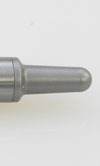Ending the bend
 Although Funny Car engines get torn down from top to bottom end between 1000-foot NHRA Full Throttle Drag Racing Series passes, it’s easy to overlook pushrods “because they are that good,” according to 2008 series runner-up and 2009 Countdown to One participant Tim Wilkerson. He’s been using “nothing but Manton pushrods” in his engines for many years citing, “Terry’s got a good product and he’s quick to fix something if it’s wrong.”
Although Funny Car engines get torn down from top to bottom end between 1000-foot NHRA Full Throttle Drag Racing Series passes, it’s easy to overlook pushrods “because they are that good,” according to 2008 series runner-up and 2009 Countdown to One participant Tim Wilkerson. He’s been using “nothing but Manton pushrods” in his engines for many years citing, “Terry’s got a good product and he’s quick to fix something if it’s wrong.”
The clearance difficulties inherent with a nitro-burning Funny Car engine define the specification of pushrod. “We have clearance problems in the cylinder head and the block, so making the pushrod strong enough to work under the conditions these cars work under,” is the biggest challenge for Wilkerson.
The intake and exhaust pushrods he employs are of standard chrome moly material with a proprietary heat treat. Wilkerson use a straight pushrod; “they’re not tapered like a lot of them. We were bending them up when we had a 0.130 wall but now that Terry’s gone to a 0.160 wall, it’s helped a lot.”
Wilkerson checks his pushrods after every run to make sure they’re not bent. “On average we probably get about 25 runs out of the pushrods; that’s a lot of runs.” He cites the move to the thicker wall for helping lengthen the life cycle. “We were bending them up when we had a 0.130 wall. We usually only have a problem when the thing smokes the tires and they get bent about 2-3 times when the valvetrain is trying to catch up.”
The result is a blacked pushrod end, “Which means the heat treat wasn’t good on it or something like that. All the ends are heat treated on our pushrods. It helps make them harder. We use Terry’s adjusters, too, because the radiuses are all the same on the adjusters and the cups. That way they mate better.” Wilkerson’s crew are quick to notify him if they find a dark spot on the inside of a cup, “So we throw them away after that.”
As a result of improvements to the wall thickness and heat treatment, “We have no problems with the pushrods at all, once we got the little quirks figured out. I’d say for five years we haven’t had any oiling problems. Right now, knock on wood, that’s the part of the motor we don’t worry about very much.”
The exhaust pushrods on Wilkerson’s engines are longer than his intake. “We have three different lengths for the exhaust; we try to keep the oil in the right range because it’s tight. One about 100 thousandths or 125 thousandths. That’s all the range is, so if you get the adjuster too far up into the rocker, it won’t oil very well. The length will depend on the thickness of head gasket we’re running.”
Using an altimeter to determine his choice of head gasket, “You don’t really have too much of a problem with that. The altimeter doesn’t really change more than 100 feet over a race weekend, so we make a choice and stick with that.”
Written by Anne Proffit.